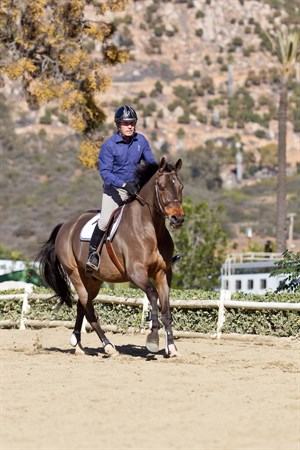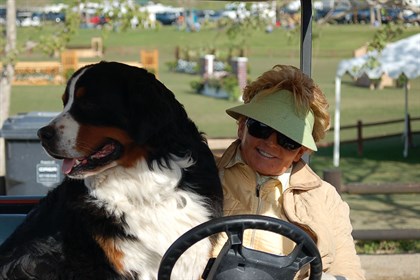|

|
This article has appeared previously with Equestrian Life. To see what's in our latest digital issue, click here.

Bernie Traurig.
Photo courtesy of Bernie Traurig
“Equitation” is bandied about a lot in the equestrian world, and seems to have different meanings, even among its proponents. Equestrian Life asked four experts from different perspectives what equitation means to them.
BY CHLOE CHADWICK
THROUGH THESE FOUR views on the definition and undertaking of equitation, it becomes clear that vital, classical elements of equestrianism remain at the discipline’s heart. Fluency, precision, subtlety, balance and softness are recurring themes that seem to encompass equitation’s core, demonstrating its importance as a discipline that encourages, above all, correctness and beauty, and developing a rider to the best of their ability. Big in the United States and well established in Europe, equitation is now making inroads in Australia. Let’s hear from the experts.
AMANDA ROSS, Jumping Equitation, the art of mastering the fundamentals
Amanda is the complete modern-day eventer and a great believer in the school of equitation. Specialising in horse and personal fitness and training, Amanda has the hands-on knowledge of the skills required to get to the top.
Equitation is about riding correctly, understanding and using correct aids, and being able to train the horse to maximise rideability and performance. The perfect equitation round should be one of rhythm, fluency and precision, the aids delivered via an “invisible ride’’. While the forward seat has been around for a century and applied to show jumping by Italian cavalry instructor Captain Federico Caprilli in the early 1900s, equitation was refined into a system by the Americans, some with European backgrounds, in the US in the 1940s. Since then, most American show jumping Olympians and World Championship winners started out competing in equitation as junior riders, giving them the solid grounding for their success.
Equitation competitions comprise a course of about 12 obstacles with one or several combinations in lines of two, three and four obstacles with a number of strides to be respected. Distances between obstacles vary. There could be compulsory turning points, transitions to trot and to walk, halts, rein-backs, obstacles to be jumped from the trot or from a counter-canter, changes of legs, in-out fences, compulsory number of strides on curves or any other assignment, allowing judges to assess the complete submission of the horse. The judge awards or deducts marks over each fence for correctness of rider position, horse technique, execution of the round, and presentation. There are many tasks that can be encountered in a round - from riding without stirrups to jumping a fence from the hand gallop - and there is etiquette for how the round is executed.
Jumping equitation is an excellent way not only to begin jumping, but to create an understanding of a solidly correct position, as well as how to train and perform the perfect round. It sets up a rider's future, creating that textbook position that so many people only dream of.
BERNIE TRAURIG, All Things Equitation
Legendary US master horseman, Bernie Traurig is renowned not only for his riding, but as a coach, mentor and trainer. He has represented the US many times internationally, including in all Olympic disciplines. An inductee to the US National Show Hunter Hall of Fame, Bernie has several Lifetime Achievement Awards honouring his contribution to the sport.
In the equestrian sport, I feel that function follows form. The more correctly you sit on a horse, the more correctly your aids will communicate with your horse. A rider should strive to complete any task that arises in competition with a beautiful and correct form, effectively using subtle aids to control the horse and being in perfect balance with the horse, whether it’s in our Hunt Seat Equitation Classes, US Equestrian Federation Talent Search classes, Jumper Divisions, Hunter Divisions, Saddle Seat, Dressage, or Western Divisions.
The focus of our Equitation Division, judged subjectively, is the rider’s form, control of the horse and effective use of aids. However, to me it should not be a posing contest, so “effective” is a big key word.
Looking back, history reflects our beginnings with the cavalry, based heavily on the forward riding system introduced by the Italians in the early 1900s. Many masters, such as General Harry D. Chamberlin, Gordon Wright, Captain Vladimir Littauer, Bert de Nemethy, William Steinkraus and others have refined and developed this system up to the present. The US Equestrian Team in the 1960s, under Bert de Nemethy, beautifully demonstrated forward riding over big, international courses. Hugh Wiley, Frank Chapot, and Bill Steinkraus, whose exemplary form is timeless, show a style that should be admired today. Today many riders worldwide, such as Beezie Madden, McClain Ward, Rodrigo Pessoa, Gerco Schroder, Eric Lamaze and Charlotte Dujardin, continue to show us how riding at the top of the international sport can be so beautifully correct!
My system of choice to develop horses and riders in the jumping discipline is heavily based on the forward riding methodology rather than the dressage-based system. In addition to the many clinics I do around the world, I have developed a visual online website to spread the education of the forward riding system to the masses. This system is based on three parts: position, use of aids or controls, and schooling programs.
(Bernie Traurig is founder and CEO of EquestrianCoach.com, which offers hundreds of training and instructional videos featuring him and 60 other world-class and Olympic coaches. For more information, visit EquestrianCoach.com).
KAREN HEALEY, Equitation Classes
Karen Healey is a leading US trainer and judge who runs her own competition stables in California and has trained students to more than 100 medal finals and hunter and jumper titles. Karen chairs the US Hunter Jumper Association Equitation Task Force and holds many senior positions in equestrian administration.
Equitation Classes refers to an American competition based upon classical and universal principals. “Equitation” is an often misunderstood and sometimes maligned term. It is frequently believed to be an American invention that produces stiff, mechanical riders. Nothing could be further from the truth. As I teach in the many clinics I give throughout the country, good equitation is nothing more than the most effective and efficient means of communicating with your horse. Most properly schooled equitation horses can easily perform a 3rd level dressage test and turn around and effortlessly jump a 1.20m jumper course.
Equitation Classes, often known as Medal Classes, are uniquely American. Riders are judged on their ability to negotiate courses of varying degrees of difficulty, in proper, classical style. By classical, I mean soft, elastic and with invisible aids. While the horse is certainly an important part of the equation, the emphasis is on the rider's ability to answer the questions posed by the course designer as smoothly as possible. Make no bones about it; the questions at the highest levels are on a par with any major jumper championship. At the recent World Cup Finals, I think that was definitely a contributing factor in having four American riders out of six in the jump-off on Friday night.
In the US, there are equitation classes for all levels and ages of riders. The USEF Pony Medal is held in conjunction with the Pony Hunter Finals and there are usually 150-200 competitors. Some are under 12 years old and competing on small ponies. The THIS Medal Finals are for intermediate riders who jump 1.0 metre. Only the top 30 riders in the country are invited to the National Finals. There is a similar class for adult riders, the Ariat Medal, which is also hotly contested. The USEF Medal Finals, held in Harrisburg, Pa., draw 250-300 riders. Riders qualify for the ASPCA Maclay Finals from regional finals, and this class includes a very comprehensive flat phase that counts for 50%. The WIHS Medal is a relative newcomer, about 25 years old, where riders are asked to ride a hunter course and a jumper course. The top 10 riders then change onto another competitor's horse and ride the jumper course. This last phase occurs right before the President's Cup Grand Prix at the prestigious Washington International Horse Show.
The USEF Talent Search is our most advanced Equitation Class. This year the finals will be held at 1.20m. This class consists of four very difficult phases. In Phase I, the Flat Phase, riders will be asked to counter-canter as well as show dressage movements such as shoulder-in and haunches-in. Phase II is Gymnastics, Phase III Jumping, and in Phase IV the top four riders all ride each other's horses in the same format as WEG.

Karen and Max.
Photo Credit Jackie McFarland EqSol
Anyone who thinks this produces stiffness or mechanical riding is very mistaken. The mission statement of the Equitation Task Force is: "To produce riders who can compete in the hunter ring and/or the jumper ring both nationally and internationally.” So many of our top international riders - McLain Ward, Lauren Hough, and Kent Farrington, to name a few - all got their start in the equitation ring, all winning at least one National Final. I don't think there is anyone in the world who doesn't have the utmost respect for Beezie Madden, and she does it all with beautiful style. No one believes that equitation is an end in itself, but based on the riders we are producing, I am going to stick with the standards I learned from my mentors.
GILL KENNERLEY, Working Equitation
Gill Kennerley is an international dressage trainer and founder of Working Equitation in Australasia. WE is an established discipline in Europe and Gill began training in it in 2002 with Portuguese trainers in the UK before bringing it to Australia in 2007.
What is working equitation? WE is a fun way to train seriously. It is a sport or discipline to test a horse and rider through a range of activities, combining flat work, (dressage) movements and obstacle tests. Horse and rider are required to negotiate obstacles as if they were working in the field with cattle. There are four phases: dressage test, obstacles (style), speed test, and team cattle penning (optional) used in international competitions.
The first European championships were held in Italy in 1996. WE is in its infancy here, but is established in the UK, Spain, Italy, Portugal, France, Belgium, Sweden, Mexico Brazil and the US. Each country has its own governing body, and to compete internationally you have to be a member of the World Association of Working Equitation. When I immigrated to Australia from the UK in 2006, I saw a need for correct equitation training here, so began training WE in 2007 and founded Working Equitation Australasia in 2008.
WE is open to riders of any age and experience - novice to advanced - and any breed or type of horse can be used. Riders need to train correctly, using all the basic dressage and lateral movements, working toward collection. The horse needs to be supple, obedient and precise. By supple, I mean the horse should develop balance and the correct muscle tone to perform the dressage and obstacle tests with ease. Obedience means the horse should work in balance and harmony with its rider, responding to every invisible aid, showing complete balance and control, working in harmony without any force. Precision is important when riding all four phases.
Riders are judged in the obstacle tests on the way they negotiate the obstacles, the approach, the task being performed correctly and the journey between each obstacle, the canter departures, correct rein-back steps, square halts, obedience, style and elegance. There are many competitions now available for riders to compete in. For more information visit workingequitationaustralia.com.
|

|

